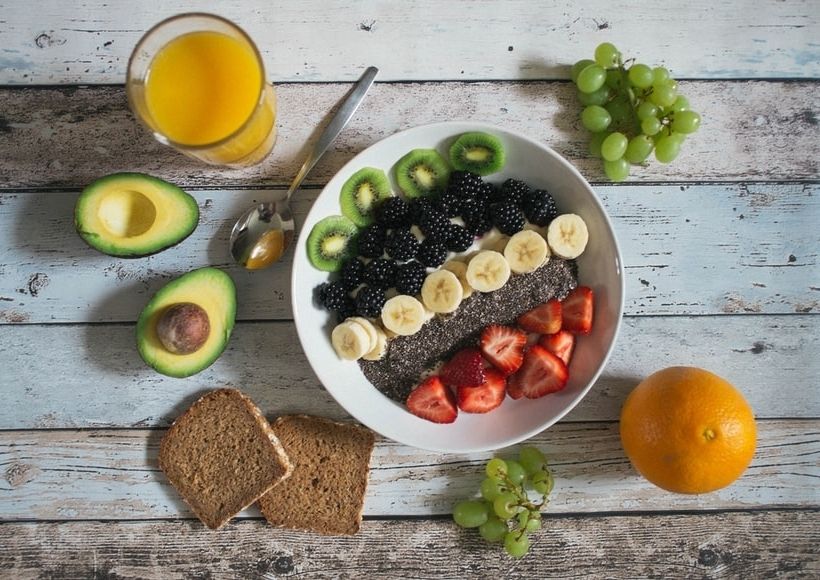Table of Contents
This Is How The Food Combining Works.
Which Principle Is The Food Combining Base On?
The inventor of the food combining diet, William Howard Hay, was convinced that humans could not digest protein and carbohydrates simultaneously. If both nutrients are eaten simultaneously, a process starts in the intestine that blocks the metabolism of carbohydrates and proteins. In addition to over-acidification of the intestinal flora, the consequence is a steady increase in weight. According to Hay, the key to the correct weight is not to eat protein-rich and carbohydrate-rich foods together or in quick succession. Hence the name of the diet: food combining.
With this type of diet, the digestive processes could run much more efficiently. The individual digestive enzymes would then do their work undisturbed – the food would be digested better and faster, excess kilos would be broken down again. As a side effect, the general well-being also increases through the food combining since the over-acidification gives way to a balanced acid-base balance.
This theory has now been scientifically refuted. However, the food combining can show some weight loss successes. The preoccupation with your food is to be positive and creates more attention for the diet; these are good prerequisites for sustainable diet success. Therefore, food combining for those who want to lose weight is worth considering.
What Does This Mean For The Diet?
How Can A Balanced Acid-Base Balance Be Achieved?
According to Hay’s food combining theory, there are three groups of foods. On the one hand, the so-called base builders, on the other hand, the acid-forming foods, have to be combined to achieve a balanced ratio. There is also a neutral group that does not influence the acid-base balance. Hay recommends consuming four-fifths of essential ingredients and one-fifth of acidic components.
What Are Base-Forming Foods?
These are foods that shift the pH value in the digestive tract to alkaline. This includes mainly plant-based foods: fruit and berries, potatoes, beans, lettuce, whole grain cereals, and almost all types of vegetables.
Which Foods Are Acidic?
These are mainly animal products: milk and cheese, fish, meat, and sausage. Refined sugar and white flour and the products that mainly consist of them belong to the acid formers—for example, sweets and white bread or cakes.
What Are Neutral Ingredients?
In addition to the two main groups, some foods do not belong to one or the other group of ingredients. This group only includes fats such as butter and lard, (cold-pressed) oils, and margarine. In any case, these should be used sparingly to save calories.
The Core Of Food Combining Is The Separation Of Carbohydrates And Proteins.
In addition to the acid- and base-forming foods that should be mixed, the core of the food combining is the distinction between carbohydrate-rich and protein-rich foods that must not be mixed. Here, too, a third neutral group does not belong to either one or the other category and can be combined with both dishes as part of the food combining.
Which Dishes Should You Separate?
The Carbohydrate Group
Foods containing carbohydrates in the sense of food combining are, of course, sugar and flour, and dishes that have them. This means that all types of bread, cakes, and other baked goods fall under this category. In addition, pasta, rice, and potatoes and pumpkins, all kinds of sweets, and many sugary fruits such as bananas or pineapples. Dried fruits (dates, raisins, figs) and canned fruits and jams, where sugar is used as a preservative, also have a high carbohydrate content. Honey or agave syrup and syrup also belong to the carbohydrate group in the food combining.
The Protein Group
Unsurprisingly, the protein group includes:
- Eggs.
- Meat and poultry.
- Fish and seafood.
- Dairy products with a fat content of less than 50 percent of the dry matter.
Except for dairy products in the “double cream” category and some types of soft cheese, these are practically all types of (fresh) cheese, milk, yogurt, quark and cream. Many plant products also belong to the protein group: First and foremost, these are products made from soybeans and all berries except blueberries. In addition, citrus fruits as well as stone and pome fruits.
Side Dishes In The Food Combining: The Neutral Group
If you look at the two groups to be separated, the list of ingredients seems rather bland. Fortunately, the neutral group in the food combining can be combined as a side dish with both carbohydrates and proteins.
Most vegetables belong to the neutral group. This also applies to salads and mushrooms. Avocados, cucumbers, and melons can also be found in this group. Animal fats (lard, butter) are also included in the food combining theory as neutral ingredients. Cheese with more than 50 percent fat in the dry matter and peanuts, which are pulses, are also part of the impartial group.
Combining Food Tables Help With The Compilation Of Meals
With a food combining table, a complete meal can be put together quickly and easily. Each ingredient belongs to one of the three groups. Critics of food combining complain that the group assignment is more or less arbitrary. Soybeans or nuts, for example, contain both carbohydrates and protein and should therefore not be eaten at all. Nevertheless, they are assigned to the protein group. This also applies to many other ingredients; very few foods contain only protein or only carbohydrates.
Food Combining In Conclusion
The theory behind the food combining cannot be scientifically proven. Regardless of this, the change in diet promises effective weight loss without hunger. Another positive aspect is that malnutrition is not to be feared. However, it is difficult to stick to the food combining diet in everyday life due to many rules and prohibitions. However, if you have enough discipline and do not shy away from nutritional theory, you can lose weight safely with a food combination.
Also Read : What is cadmium, and what foods have it?

